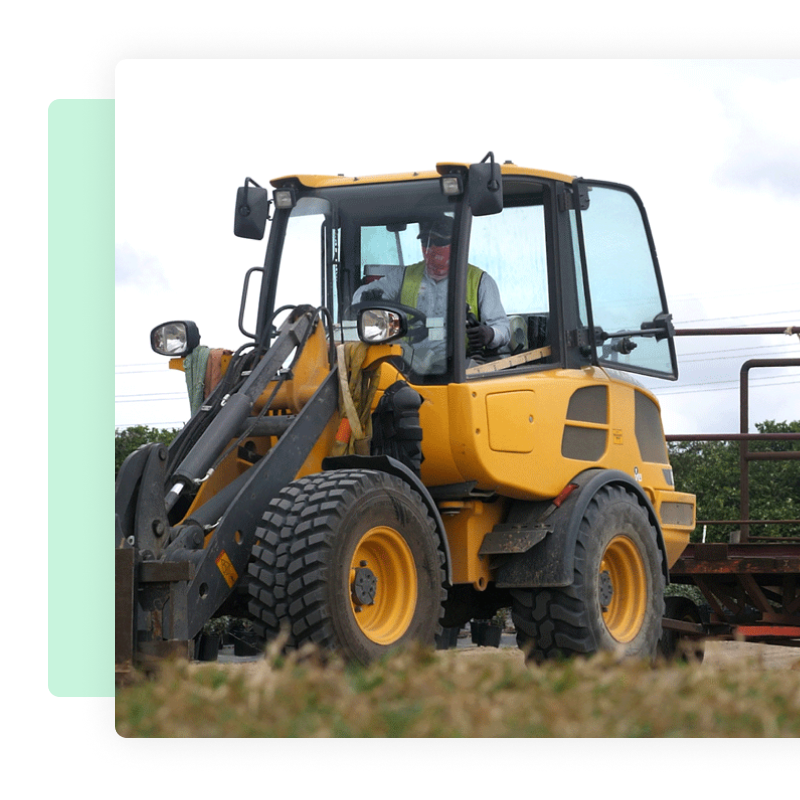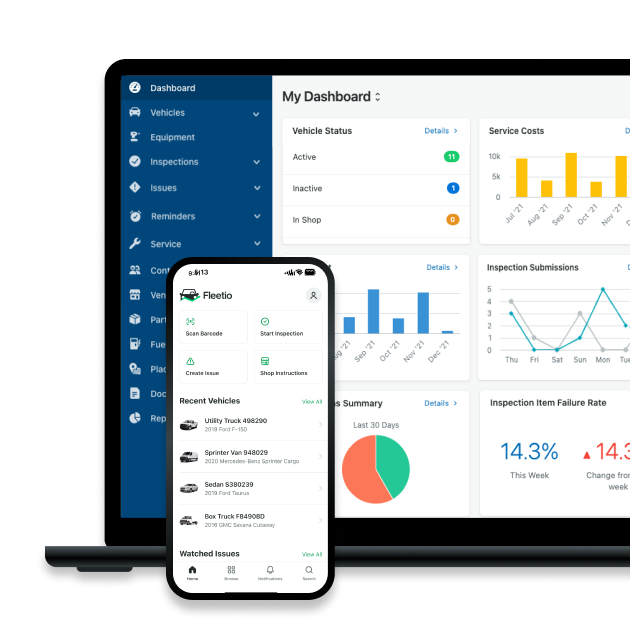4 Tips to Maintaining Your Farm Equipment Through Each Season
Farm equipment is the backbone of any agricultural operation and plays a vital part in planting, harvesting and other crucial farming tasks. But farming is, by its nature, a seasonal endeavor, and the usage of your equipment will ebb and flow throughout the year, moving with planting and harvesting seasons.
Oct 18, 2023
7 min read

TL;DR: What is seasonal maintenance?
Seasonal maintenance is key to keeping farm equipment reliable, efficient, and ready for planting, harvesting, and downtime - no matter the season.
Pre-planting season: prepare for success
- Inspect and clean equipment to spot wear early and prevent corrosion
- Lubricate all moving parts per manufacturer guidelines to reduce friction and wear
- Test hydraulics and electronics to ensure everything runs smoothly before fieldwork begins
Pre-harvest season: maximize yield and uptime
- Sharpen or replace blades for clean cuts and higher-quality harvests
- Check belts and chains for tension, alignment, and wear to avoid breakdowns mid-harvest
- Calibrate and test equipment to match crop conditions and ensure accurate operation
Off-season: protect and preserve
- Deep clean all equipment to prevent rust and prolong lifespan
- Change fluids like oil, coolant, and fuel to maintain engine health in storage
- Track maintenance history to guide future work and inform replacement planning
Maintaining your equipment seasonally reduces costly downtime and extends its life - and the right fleet management software makes it easier to stay on track year-round.
Keeping your farm equipment in top condition when it experiences significant rolling downtime can be a challenge, so it’s essential to adapt your farm equipment maintenance and repair strategies to the unique demands of each season.
Let’s take a closer look at what farming fleets can do in each season to ensure their equipment’s continuous quality and effectively manage the pre-planting, pre-harvest and off-season periods so their operations run smoothly year-round.
Pre-Planting Season: Preparing for Success
As the planting season approaches, making sure your farm equipment is in prime condition for the work ahead is of the utmost importance. Follow these tips for managing maintenance and repair to get ready for a successful planting season:
1. Inspection and Cleaning: Prepare for a Fresh Start
The pre-planting season is your best chance to restore your farm equipment to a condition that will serve you in the busier seasons to come. Begin with a thorough audit and inspection of every piece of equipment, paying close attention to crucial components like belts, chains and bearings. Any signs of wear or damage should be addressed promptly.
It may seem like a small step in the grand scheme of things, but regular thorough cleaning not only keeps your equipment looking good but can also help prevent corrosion and maintain the integrity of the components of each piece of equipment. Be sure to give your equipment a good scrub down at the start of the season to remove any dirt, residue or debris that could cause wear and tear.
2. Lubrication: Keep Things Running Smoothly
Lubrication is essential for keeping your farm equipment running smoothly. Ensure all moving parts are well-lubricated using your manufacturer’s recommendations. Pay special attention to greasing joints and bearings.
A lack of lubrication can lead to a level of friction that’s detrimental to your equipment and causes premature wear and reduced efficiency. Stay on top of lubrication and implement a PM schedule that includes lubrication to keep your equipment operating at its best.
3. Replace Worn Parts: Maintain Efficiency
As you inspect your equipment, take note of parts that show signs of wear and tear. Replace any components like belts, blades and filters that may have seen a little too much action last season, and don’t forget to check and replace hydraulic hoses.
Regularly replacing worn parts not only ensures efficient equipment operation but also minimizes the risk of costly breakdowns during the planting season. Keep a well-stocked inventory of spare parts to expedite replacements when necessary.
4. Test Equipment: Verify Performance
You should conduct operational tests to verify that everything is still working correctly, specifically testing hydraulics, electrical systems and controls to identify and address any issues promptly.
Testing equipment before the planting season lets you detect and solve any problems in a controlled environment. This proactive approach minimizes the risk of equipment breakdowns during critical planting operations, which means you stay on schedule and maintain your productivity.
Fleet Software for Farming
Want a better way to keep track of maintenance throughout every season?
Explore Fleetio for your farmPre-Harvest Season: Maximizing Yield
Before the harvest season, it’s essential to fine-tune your farm equipment to maximize yield and efficiency. Here’s a checklist for pre-harvest maintenance and repair:
1. Blade Sharpening and Adjustments: Optimize Crop Harvest
Your harvesting equipment, including combine harvesters and balers, need sharp blades to ensure a clean cut. Dull blades can damage crops during harvesting and reduce your overall yield for the season. Sharpening and adjusting blades on harvesting equipment will mean cleaner cuts, and if there’s too much wear on your blades, replace them.
We recommend keeping spare blades on hand so you can quickly swap them out as necessary. You should also make sure your team is trained to perform blade maintenance and replacements correctly to avoid misalignment or injury.
2. Check Belts and Chains: Ensure Smooth Operation
Belts and chains on tractors and combines can wear down overtime. Be sure to inspect belts and chains for wear, check for proper tension and alignment, and replace any damaged or weakened components so they don’t break on the job.
A malfunctioning belt or chain can upend your entire harvesting process, leaving you stranded in the field with a downed piece of equipment. Regular checks and replacements will help maintain the efficiency and reliability of your equipment.
3. Calibration and Testing: Optimize Performance
Many pieces of farming equipment require very precise measurements and settings to stay operational, so doing regular checks is vital. Calibrate sensors and gauges to reflect accurate measurements during harvesting operations, and always test and adjust the equipment to match the specific crop conditions.
Calibration and testing are essential to optimize yield and ensure that your equipment operates efficiently. Keep detailed records of calibration settings for reference in subsequent harvest seasons.
4. Safety Checks: Prioritize Operator Safety
Safety should always be a top priority. Before you begin harvesting, verify that safety features like emergency stops and guards are in proper working order, and ensure all safety signage and warnings are clear and visible to anyone operating the equipment.
Investing in safety equipment and practices is crucial to protect yourself and your operators and will minimize accidents on the farm. A quick safety training pre-harvest can go a long way to protecting your team and should always be part of your farm operation protocols.
Off-Season: Preventive Maintenance and Storage
During the off-season, you have the opportunity to perform more extensive preventive maintenance and properly store your equipment for the next year. Follow these steps:
1. Thorough Cleaning: Prevent Corrosion
Your farm equipment will have been through some heavy wear and tear throughout planting and harvest, so it would be time for a detailed cleaning to remove any remaining debris and prevent corrosion. Pay attention to areas like engine bays, undercarriages and storage areas.
Proper cleaning and protection prevent rust and corrosion, extending the lifespan of your equipment. Consider using protective coatings and rust inhibitors for long-term storage in the off-season, which will also help reduce the amount of cleaning and preparation needed before planting.
2. Fluid Changes: Maintain Engine Health
During the off-season, change engine oil, transmission fluid and coolant. Empty fuel tanks or use fuel stabilizers to prevent fuel degradation while the equipment is not in use.
Changing fluids ensures that your equipment’s engine and components remain in good condition during storage and can help prevent the formation of harmful sludge, protecting the engine from unnecessary wear and corrosion.
3. Store Equipment Properly: Protect Your Investment
Shelter your equipment from the elements in a dry and secure storage area, being sure to keep tires off the ground and use tire covers to prevent flat spots.
Storing your equipment properly prevents exposure to harsh weather conditions, which can lead to equipment degradation. Indoor storage is obviously the best solution, but if it’s not available, use high-quality covers to shield your equipment from the elements.
4. Maintenance Records: Document Your Efforts
Maintain detailed records of all the maintenance and repairs you performed during the off-season, or any season, at that. Keeping detailed records will help you plan for future maintenance and assess the overall health of your equipment, which makes it easier to determine when it might be time to replace some of your older pieces of equipment.
Tailoring your maintenance strategies to the unique demands of each season is a great way to ensure that your farm equipment remains reliable and maximizes productivity. A comprehensive farm equipment maintenance software can streamline that process even further by helping you keep track of documentation and schedules with automations and mobile reminders.
Make proactive maintenance and repair a priority, and your farm equipment will reward you with reliable performance and longevity. With the right fleet management software, you can navigate the seasonal maintenance challenges of pre-planting, pre-harvest and off-season with confidence, knowing that your equipment is ready to face the rigors of farming.
Maintain your equipment through every season.
From pre-planting audits to off-season maintenance, keep track of all of your equipment in Fleetio.
Get a personalized walkthrough
Senior Fleet Content Specialist
As a Senior Fleet Content Specialist at Fleetio, Peyton explores the voices and experiences that shape fleet operations. She focuses on how fleet professionals adopt technology, improve efficiency and lead their teams to bring clarity and context to the challenges happening across the industry.
View articles by Peyton PanikReady to get started?
Join thousands of satisfied customers using Fleetio
Questions? Call us at 1-800-975-5304

